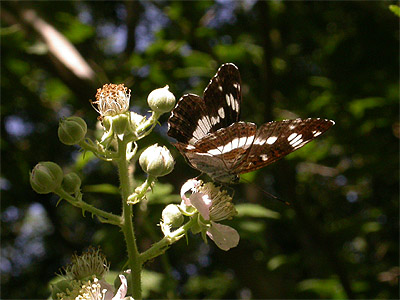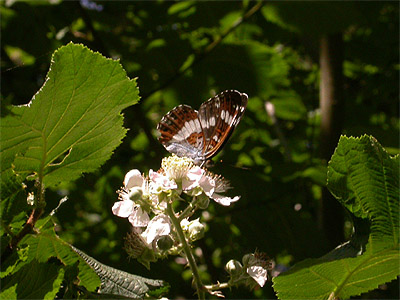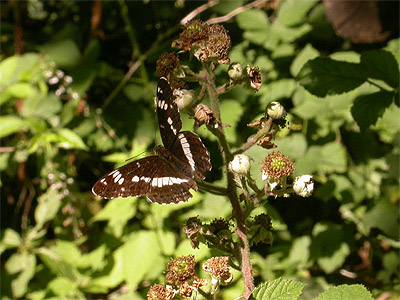

| Butterflies |
| The White Admiral in Nottinghamshire |
 |
One of Nottinghamshire's
rarest butterflies, the White Admiral (Ladoga camilla) is on the wing through June and
July. In July 2005, we went to Eaton Wood near Retford in
search of this beautiful woodland butterfly. A natural colonisation? The White Admiral's colonisation of Nottinghamshire is a fairly recent event, with adults first being reported from a site in the north-east of the county during the early part of the 1990's. In order to enable the butterfly to gain a secure foothold, the identity of the site was surpressed. Eventually the location was released and people were allowed access. Although the timing of the
White Admiral's arrival has coincided with the spread of
several other butterflies, there has always been some
element of doubt as to whether it arrived back in
Nottinghamshire through a natural re-colonisation or was
actually introduced from captive breeding stock. |
|
| The verdict
seems to have fell in favour of captive-bred stock being
released, but this does'nt take into account the fact
that the White Admiral is a difficult species to breed.
My own experiences showed that wild-caught females very
rarely laid a single egg in captivity and it was
impossible to obtain a large enough quantity of gravid
females to even attempt a serious captive breeding
program, without depleting the wild population at any
collection site. With the White Admiral population seemingly doing well in Lincolnshire and the butterfly expanding it's range throughout the southern half of the UK over the last few dacades, a natural colonisation of Nottinghamshire seems far more likely than re-introduction. |
||
| .... | ||
|
There was also the record of a White Admiral from Colwick Park in the Summer of 1994, so perhaps it could have been expected to colonise over time, if it's population continued to spread elsewhere. The one thing against this, would be that White Admirals are reluctant to (and rarely) move away from typical woodland habitat. The Comma, Speckled Wood, Gatekeeper and Ringlet, have all spread across the county since the late 1980's, by using roadside verges, hedgerows etc - all less particular (and far more abundant) habitat than that required by the White Admiral. And only a decade ago, the Brown Argus would have been the last species on many peoples list to turn up in the county again, especially after 40 years. However, it has done and is still continuing to spread. Habitat requirements White Admirals prefer largely deciduous woodland where Honeysuckle grows under the crowns of trees and Brambles grow in profusion. They do occur within mixed woodland, but generally avoid conifer plantations. Honeysuckle is the sole larval foodplant. |
 |
|
| .... | ||
 |
Where and when The most accessible site to see the White Admiral is at Eaton Wood near Retford. The wood is owned and managed by the Nottinghamshire Wildlife Trust. Access is via the A638 south of Retford, taking the minor road from Eaton to Upton. Parking is severely limited and not allowed on the protected grass verges. Go through the main gate at SK727772 to enter the wood. White Admirals are very obvious butterflies and are greatly attracted to the flowers of Bramble. Sitting near a Bramble patch on a sunny, warm day, should soon pay dividends. We visited Eaton Wood on July 17th 2005 and soon found a single White Admiral after a short walk down the main ride. We parked on the left-hand side of the road going up the hill and went in that particular section of the wood, but it may be better on the other side. The individual pictured showed particularly well and was very confiding. |
|
| References: . M Dennis & M Walker - Finding White Admiral in Notts - Nottinghamshire Naturalist Vol 2; Issue 4, Aug 1999. | ||